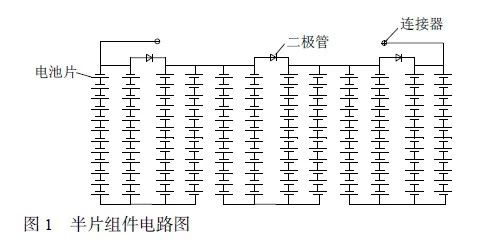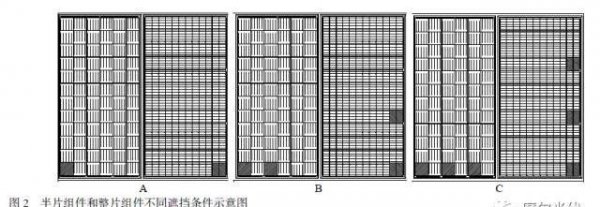
Privacy statement: Your privacy is very important to Us. Our company promises not to disclose your personal information to any external company with out your explicit permission.
Abstract: Half-chip technology is an effective way to reduce component packaging losses and increase component power. This article studies from two aspects: power increase of half-cell battery module and shadow shading of cell. The experiment compared the electrical parameters of 144 half-chip polycrystalline modules and 72 full-chip modules. The experiment shows that the half-chip module made with the same efficiency battery has 9W higher power than the conventional whole-chip module, and Imax and Isc increase by 1.16% and 1.32%, respectively. This paper further studies the effect of shadow occlusion on the electrical performance of half-chip components. The half-cell battery module and the whole-cell battery module cover cells of the same area. The power loss of the half-cell battery module is lower than that of the whole-cell battery module. When the blockage area of the half-cell battery panel reaches about 90% of the half-cell battery panel, the half-cell battery module Vmax becomes unblocked About 2/3 of the hour.
0 Preface
In recent years, photovoltaic technology has developed rapidly and has a wide range of applications. The market's demand for high-power components has also increased. Reducing component packaging losses and increasing component output power have become the research trends of domestic and foreign component manufacturers. Among them, the half-chip technology is a technology to improve the power of the component by reducing the size of the battery chip and reducing the series resistance loss. By laser cutting standard-size cells into two half-cells of equal size, the current through each busbar can be reduced to 1/2 of the original, and the internal loss is reduced to 1/4 of the whole cell, thereby improving the component power. At present, Norway REC, Japan Mistubish and Germany Boschsolar have already developed half-chip module products.
SCHNEIDER et al. [1] used the four-point bending method to test the mechanical properties of half-cell and whole-cell batteries. The results showed that half-cell batteries had better mechanical properties than whole-cell batteries. The experiment verified that 144 half-cell modules had higher power than 72 conventional full-cell modules. 5%. HANIFI et al. [2] verified the performance of the half-chip module when shadowing the cell by simulation and experiment. The experiment showed that the half-chip module under shadowing had better performance than the whole chip module. MALIK et al. [3] studied the difference between the half-module and the whole-module outdoor power generation. The experimental results show that the half-module power station's monthly power generation is 1.9% -3.9% higher than the whole-module power generation, and the power generation gain is high when the irradiance is high Big [1-5].
At present, there are few experimental studies on the shadow shielding of the battery from the circuit design of the half-chip module. This paper studies the power improvement of the half-cell module and the shadow shielding of the cell. The experiment compared the electrical parameters of 144 half-chip polycrystalline modules and 72 full-chip modules. Considering the design of series and parallel of half-chip modules, and further comparing the electrical parameters of 144 half-chip polycrystalline modules and 72 full-chip modules under different cell shielding conditions.
1 Experimental part
1.1 Half-chip component product design
The internal structure design of the half-chip module includes a series structure and a parallel-series structure, a series-parallel structure. The conventional module usually adopts a series structure. Since the current is halved after the half-cell battery is diced, the voltage remains unchanged. The component voltage is double that of conventional components, increasing system cost. This experiment uses 144 half-chip components in parallel. Series circuit design, as shown in Figure 1.

1.2 Experimental samples and instruments
The cells used in all the components in this experiment are five-grid P-type polycrystalline silicon solar cells with the same efficiency. The photovoltaic components are encapsulated with tempered glass of the same manufacturer and the same specifications, conventional EVA materials and TPE structure backsheets. The half-cell module uses a three-piece junction box. The photovoltaic welding tapes used are all conventional surface structure welding tapes. The welding tape specifications are 0.25mm × 1.0mm (thickness 0.25mm, width 1.0mm).
The PV module power test equipment is the Pasan solar simulator; the internal cell cracking equipment for the inspection module is the OPT200A EL tester of the German Ophelms company.
Based on different series and parallel structures, the same material is matched to produce 72 full-chip components and 144 half-chip polycrystalline components, and 2 components are prepared for each type. The specific sample types and quantities are shown in Table 1.

1.3 Experimental content
Experiment 1: Test the EL and electrical parameters of two 72-piece polycrystalline whole-chip components and two 144 polycrystalline half-chip components, and make a comparative analysis.
Experiment 2: Based on the P-type polycrystalline solar cell, the whole module sample a-1 and the half module sample b-1 were selected to conduct the cell blocking test. The initial stability of 20kW · h / m2 illumination, the blocking material is non-light-transmitting material. According to the number and location of the battery pieces protected by different diodes, the schematic diagram of battery blockage is shown in Figure 2. After the module is placed in the Pasan solar simulator for power testing, and compare the changes in electrical parameters of the whole module and half-module.

Experiment 3: In order to verify the electrical parameters of the half-modules with different shielding areas, one of the half-cell modules was blocked by 50%, 60%, 70%, 80%, 90% of the battery area and placed in the Pasan solar simulator , Test electrical parameter differences. The block diagrams of different areas of the battery slice are shown in Figure 3.

2 Results and discussion
2.1 Comparative analysis of electrical parameters
The EL diagrams of the experimental samples are shown in Figure 4. All the samples of the components are intact, and there are no cracks or battery defects. The electrical parameters of half-chip components and whole-chip components are shown in Table 2. As can be seen from the table, the power of half-chip modules made with the same efficiency battery is 9W higher than that of conventional whole-chip modules, and Imax and Isc increase by 1.16% and 1.32%, respectively. Analyze the reason, the important index that affects the power of the solar cell module is the packaging loss. The packaging loss mainly depends on the series resistance loss and optical loss of the packaging material. The series resistance of the solder tape is the main cause of the power loss. The improvement of absorption and optical matching performance between them makes it possible to achieve the effect of power gain [2]. Laser cutting of standard-size cells into two half-cells of equal size can reduce the current through each main grid to 1/2 of the original, internal loss is reduced to 1/4 of the whole cell, and the half-component layer After pressing, the white space between the sheets increased. In the experiment, the gap between the half-piece and the whole piece increased by 9.5cm2, which increased the light receiving amount of the cell and reduced the optical loss.


2.2 Comparative analysis of occlusion experiments
According to the experimental method in the experimental content 1.2, test the power conditions of the half-chip module and the whole-chip module under the three blocking conditions of A, B and C. The specific data is shown in Table 3. According to the experimental method of Experimental Content 1.3, the electrical parameter performance of the half-chip module under the condition of different areas of the monolithic battery is tested. The specific data is shown in Table 4.


From the data, it can be seen that due to the particularity of the parallel-series connection structure of the half-chip module, when the same area of the battery under the protection of a diode is also blocked, the power of the half-module of the parallel-series structure is better than that of the whole-chip module of the series structure under the three blocking conditions. . Similarly, when the shielding area of the battery plate reaches about 90% of the half of the battery plate, the voltage becomes about 2/3 of that when there is no shielding. It can be judged that this shielding area bypasses a parallel circuit. In real power plants, the components are mostly installed vertically. When there is shielding in front of the array, the bottom row of cells is the first to be affected by the shadow, and the entire series structure is likely to block the entire row below during the actual shadowing process. Cells, this row of cells may cause three diodes to start, which affects the power generation of the entire module, and the design of the parallel structure of half-chip modules, the bottom row and even four rows of cells are controlled by a diode Therefore, the shadow that occurs in the same situation will only affect 1/3 of the power of the component, thereby reducing the loss of power generation caused by the shadow.
3 conclusions
In this paper, we study the power loss and module occlusion of the half-chip module, and analyze the influence of the half-cell module on the module power. Through the analysis of the optical loss and electrical loss that affect the power of the module, it is concluded that the half-cell module is an important way to increase the power of the module. Experiments show that the power of a half-chip module with the same efficiency is more than 9W higher than that of the whole chip module. And under the same shadow, the special structure design of the half-chip module will reduce the power loss of the module in the power station, and the performance is better than the whole chip module.
November 16, 2024
November 14, 2024
September 18, 2023
June 28, 2024
June 28, 2024
この仕入先にメール
November 16, 2024
November 14, 2024
September 18, 2023
June 28, 2024
June 28, 2024

Privacy statement: Your privacy is very important to Us. Our company promises not to disclose your personal information to any external company with out your explicit permission.

Fill in more information so that we can get in touch with you faster
Privacy statement: Your privacy is very important to Us. Our company promises not to disclose your personal information to any external company with out your explicit permission.